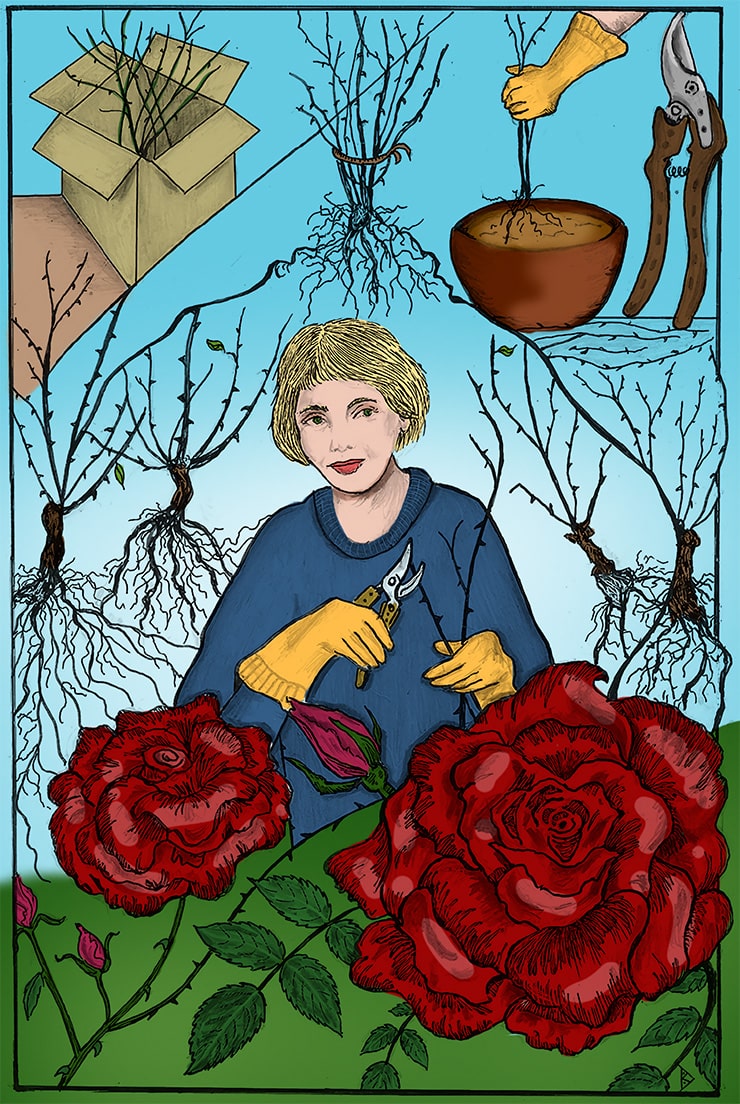Read by Matilda Longbottom
Author’s Note: For two years, I was a member of a small team that prepared 4,000 rootstocks every spring at our local independent garden center in Chicago. I had grown and tended perennials, annuals, and herbs for more than a decade, but I knew nothing about roses. The Master Gardener in charge of our team was very patient with me.
The contents inside the large and soggy cardboard box are unimpressive when you peel away the plastic coverings: tightly-stacked, plastic tie-bound bundles of 10 sharp, green, thorny sticks, each stick growing out of a muddy, rope-like mass. You reach into the box with your gloved hands and extract a bundle of rootstocks and canes. After taking your first bundle to a large open water tank, plunging it several times to wet the roots so they will not dry out in your care, you find space at the wood-slatted, paint-warped table outside the greenhouse door, undo the ties, and begin your work.
The expert on hand—a Rose Whisperer—advises you to take a moment before you cut to assess the living thing you hold. Look closely at how the rose canes grow out of the root. Calm and quiet, she tells you to focus on the center where canes may crowd each other. Find where they cross or grow inward and determine what looks unnecessary or dead, broken, or sick. Clip away these distractions and weaknesses with the understanding that it costs the plant too much energy to nurture the extraneous.
Yes, you may get scratched.

Gently tap your metal pruners against the remaining canes and listen for a strong and sturdy sound, like a fist knocking on a wooden door. These canes are the healthiest ones; a rose needs all the strength it can muster if it is to realize its potential.
Next, attend to the top of the cane. Cut it down to where a bud is starting to grow, preferably outward toward space and light and not inward toward confusion and entanglement. Inspect the inner cane, which should be green and growing. Peer closer and you may see small rings that fleetingly remind you of the huge fallen tree in your favorite redwood forest.
Lastly, cut the tangled roots, being mindful that the plant needs both the strong, thick ones that will anchor it into soil (do not clip them so short that they are useless) and the delicate, spidery roots that shoot out through dirt toward nutrients to consistently feed the plant’s new growth. Balance.
Falling into a rhythm, you prune hundreds of canes, your focus evident in the piles of detritus that collect around you. You eradicate rot, mold, splitting, or softness on the plants that pass through your hands. You gain precision and confidence, although sometimes a rose requires such extensive time and effort that what is left seems an excuse of a plant: canes that look like magic wands, divining rods, a gymnast doing a split, or a skeleton’s hand. Sometimes you guess at what to do, take a chance, and hope for the best. When you worry that you’ve cut too much or acted too rashly, the Rose Whisperer assures you that, despite their reputation for being prissy and needy, roses are much stronger and more resilient than your new-to-this self can imagine.
You’ve been assessing roots and canes, deciding what must go in the interest of health and energy, encouraging new growth and nurturing unique beauty for days when the real lesson strikes you one afternoon. It’s so obvious you’re amazed it took this long for you to make the connection: in pruning a rose, you are not “just” gardening.
You are shaping a life.
So pay attention. Value resilience. Muster strength. Make choices. Take chances. Remain hopeful. And marvel at the fragrant possibility of it all. ❖
This article was published originally in 2021, in GreenPrints Issue #125.



